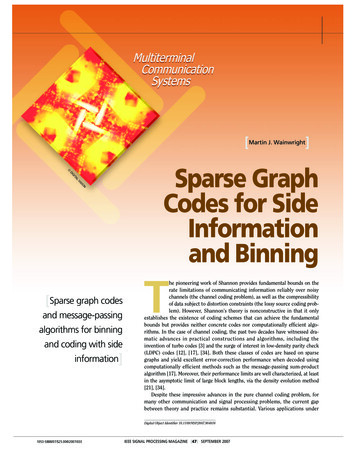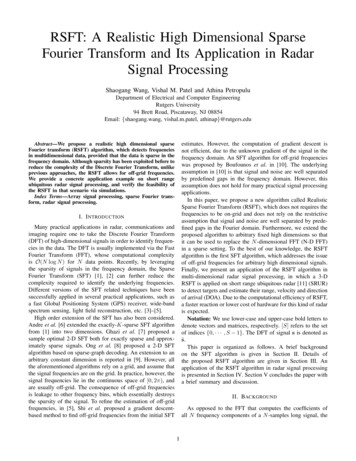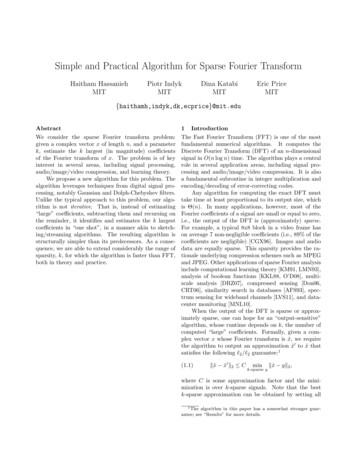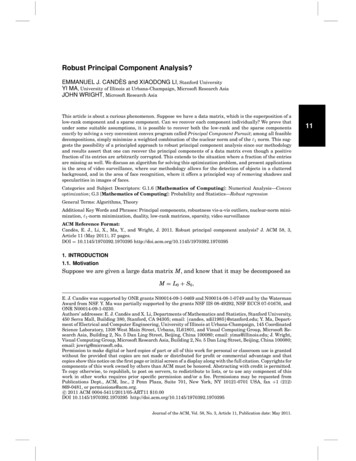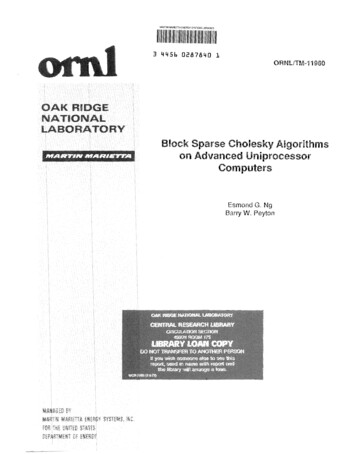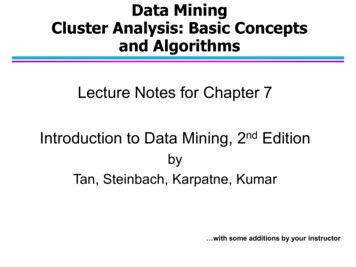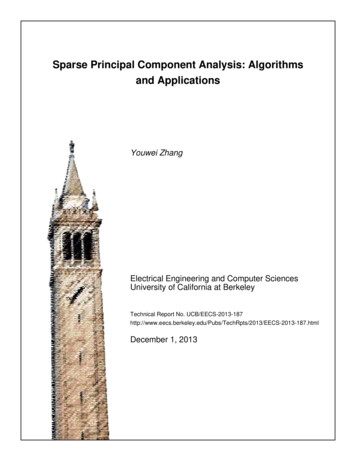
Transcription
Sparse Principal Component Analysis: Algorithmsand ApplicationsYouwei ZhangElectrical Engineering and Computer SciencesUniversity of California at BerkeleyTechnical Report No. /TechRpts/2013/EECS-2013-187.htmlDecember 1, 2013
Copyright 2013, by the author(s).All rights reserved.Permission to make digital or hard copies of all or part of this work forpersonal or classroom use is granted without fee provided that copies arenot made or distributed for profit or commercial advantage and that copiesbear this notice and the full citation on the first page. To copy otherwise, torepublish, to post on servers or to redistribute to lists, requires prior specificpermission.
Sparse Principal Component Analysis: Algorithms and ApplicationsbyYouwei ZhangA dissertation submitted in partial satisfactionof the requirements for the degree ofDoctor of PhilosophyinElectrical Engineering and Computer Sciencesin theGRADUATE DIVISIONof theUNIVERSITY OF CALIFORNIA, BERKELEYCommittee in charge:Professor Laurent El Ghaoui, ChairProfessor Martin WainwrightProfessor Jasjeet SekhonFall 2011
Sparse Principal Component Analysis: Algorithms and ApplicationsCopyright c 2011byYouwei Zhang
AbstractSparse Principal Component Analysis: Algorithms and ApplicationsbyYouwei ZhangDoctor of Philosophy in Electrical Engineering and Computer SciencesUniversity of California, BerkeleyProfessor Laurent El Ghaoui, ChairThe Sparse Principal Component Analysis (Sparse PCA) problem is a variant of theclassical PCA problem. The goal of Sparse PCA is to achieve a trade-off between theexplained variance along a normalized vector, and the number of non-zero componentsof that vector. Sparse PCA has a wide array of applications in machine learningand engineering. Unfortunately, this problem is also combinatorially hard and hencevarious sub-optimal algorithms and approximation formulations have been proposedto tackle it. In this dissertation, we first discuss convex relaxation techniques thatefficiently produce good approximate solutions. We then describe several algorithmssolving these relaxations as well as greedy algorithms that iteratively improve thesolution quality.The dissertation then focuses on solving the attractive formulation called DSPCA(a Direct formulation for Sparse PCA) for large-scale problems. Although SparsePCA has apparent advantages compared to PCA, such as better interpretability, it isgenerally thought to be computationally much more expensive. We demonstrate thesurprising fact that sparse PCA can be easier than PCA in practice, and that it can be1
reliably applied to very large data sets. This comes from a rigorous feature eliminationpre-processing result, coupled with the favorable fact that features in real-life datatypically have rapidly decreasing variances, which allows for many features to beeliminated. We introduce a fast block coordinate ascent algorithm with much bettercomputational complexity than the existing first-order ones. We provide experimentalresults obtained on text corpora involving millions of documents and hundreds ofthousands of features.Another focus of the dissertation is to illustrate the utility of Sparse PCA invarious applications, ranging from senate voting and finance to text mining. In particular, we apply Sparse PCA to the analysis of text data, with online news as ourfocus. Our experimental results on various data sets illustrate how Sparse PCA canhelp organize a large corpus of text data in a user-interpretable way, providing anattractive alternative approach to topic models.2
ContentsContentsiList of FiguresiiiList of TablesvAcknowledgementsvi1 Introduction12 Sparse PCA72.1Introduction . . . . . . . . . . . . . . . . . . . . . . . . . . . . . . . .72.2A low-rank approximation approach . . . . . . . . . . . . . . . . . . .92.3A semidefinite relaxation with 1 penalization . . . . . . . . . . . . .112.4A semidefinite relaxation with 0 penalization . . . . . . . . . . . . .182.5Greedy methods . . . . . . . . . . . . . . . . . . . . . . . . . . . . . .212.6Numerical results . . . . . . . . . . . . . . . . . . . . . . . . . . . . .252.6.1Statistical consistency vs. computational complexity . . . . .252.6.2Random matrices . . . . . . . . . . . . . . . . . . . . . . . . .27Summary . . . . . . . . . . . . . . . . . . . . . . . . . . . . . . . . .282.73 Large-Scale Sparse PCA303.1Introduction . . . . . . . . . . . . . . . . . . . . . . . . . . . . . . . .303.2Safe Feature Elimination . . . . . . . . . . . . . . . . . . . . . . . . .323.3Block Coordinate Ascent Algorithm . . . . . . . . . . . . . . . . . . .343.4Numerical Examples . . . . . . . . . . . . . . . . . . . . . . . . . . .41i
3.5Summary . . . . . . . . . . . . . . . . . . . . . . . . . . . . . . . . .4 Applications44454.1Introduction . . . . . . . . . . . . . . . . . . . . . . . . . . . . . . . .454.2Non-text data . . . . . . . . . . . . . . . . . . . . . . . . . . . . . . .464.2.1Senate voting data . . . . . . . . . . . . . . . . . . . . . . . .464.2.2Stock market data . . . . . . . . . . . . . . . . . . . . . . . .48Text data . . . . . . . . . . . . . . . . . . . . . . . . . . . . . . . . .514.3.120-newsgroups data . . . . . . . . . . . . . . . . . . . . . . . .524.3.2New York Times data . . . . . . . . . . . . . . . . . . . . . .56Summary . . . . . . . . . . . . . . . . . . . . . . . . . . . . . . . . .594.34.45 Conclusions61Bibliography63ii
List of Figures1.1S&P500 daily returns projected onto the top 2 principal components.32.1Left: ROC curves when recovering the support of u in the spiked modelusing thresholding, approximate and exact greedy algorithms and thesemidefinite relaxation (DSPCA) in Section 2.3 in the spiked modelwhen n 250, m 400 and k 25. Right: Area Under ROC(AUROC) versus number of samples m. . . . . . . . . . . . . . . . . .27Upper and lower bound on sparse maximum eigenvalues. We plotthe maximum sparse eigenvalue versus cardinality, obtained using exhaustive search (solid line), the approximate greedy (dotted line) andfully greedy (dashed line) algorithms. We also plot the upper boundsobtained by minimizing the gap of a rank one solution (squares), bysolving the 0 semidefinite relaxation explicitly (stars) and by solvingthe DSPCA dual 1 relaxation (diamonds). Left: On a matrix F T Fwith F Gaussian. Right: On a sparse rank one plus noise matrix. . .293.1Speed comparisons between Block Coordinate Ascent and First-Order413.2Sorted variances of 102,660 words in NYTimes (left) and 141,043 wordsin PubMed (right) . . . . . . . . . . . . . . . . . . . . . . . . . . . .43Left: Explained variance as a function of cardinality. Right: Cardinality as a function of penalty parameter ρ. . . . . . . . . . . . . . . . .46109th Senate’s voting record projected onto the top 2 principal components. . . . . . . . . . . . . . . . . . . . . . . . . . . . . . . . . .47Left: Explained variance as a function of cardinality. Right: Cardinality as a function of penalty parameter ρ. . . . . . . . . . . . . . . . .49S&P500 daily returns projected onto the top 2 principal components.For PCA (left) and sparse PCA (right). . . . . . . . . . . . . . . . . .50PCA with 20-Newsgroups data. Left: Explained variance vs. numberof PCs. Right: 3D visualization via PCA. . . . . . . . . . . . . . . .522.24.14.24.34.44.5iii
4.64.7Sparse PCA on the 20Newsgroups data set. First three principal components and 3D visualization. The first three principal componentshave cardinalities 26, 30 and 10 respectively. . . . . . . . . . . . . . .54Sparse PCA on 1,288 New York Times articles mentioning the word“China”. . . . . . . . . . . . . . . . . . . . . . . . . . . . . . . . . .56iv
List of Tables3.1Words associated with the top 5 sparse principal components in NYTimes 433.2Words associated with the top 5 sparse principal components in PubMed 444.1Top 2 PCs from DSPCA . . . . . . . . . . . . . . . . . . . . . . . . .514.2Words associated with the first three sparse PCs. . . . . . . . . . . .554.31st PC from DSPCA on 1,288 New York Times articles mentioning theword “China” for various values of the eigenvector cardinality k. . . .571st PC from Thresholded PCA on 1,288 New York Times articles mentioning the word “China” for various values of the eigenvector cardinality k. . . . . . . . . . . . . . . . . . . . . . . . . . . . . . . . . . .574.5Words associated with the top 6 sparse principal components . . . . .584.6Words associated with the top 5 sparse principal components in NYTimes 594.4v
AcknowledgementsFirst, I want to thank my advisor, Prof. Laurent El Ghaoui, for guiding me throughmy PhD journey at U.C. Berkeley. When I first entered Berkeley and read the EECSgraduate handbook saying that “a good advisor is your mentor, friend, confidant,supporter and problem solver”, I was wondering whether there would ever exist sucha perfect advisor. Today I have to be grateful for the fact that life does give me suchan advisor. I am grateful for having an advisor as Laurent, who is constantly caring,encouraging and supportive. There is no need to mention how Laurent patientlyteaches and guides me to do research. Everything I achieve here at Berkeley wouldnot have been possible without the help and support from Laurent, literally. Evenat this stage of my life, I must say my personality is still being able to be shapedby Laurent, as I have been trying my best to become a person as kind and polite asLaurent is to others.I am also very grateful to Prof. Alexandre d’Aspremont. Alex coached me inwriting a book chapter for Handbook on Semidefinite, Cone and Polynomial Optimization, which is the basis for the second chapter in this dissertation. Working withAlex has always been a very enjoyable and inspiring learning experience for me. Iwant to also thank Prof. Martin Wainwright and Prof. Jasjeet Sekhon for servingon my dissertation committee. I took one probability class and one statistics classwith Martin, and he is one of the best instructors that I’ve ever had. His clear andinsightful lectures lay a good foundation for my probability and statistical knowledge.As the outside member on my dissertation committee, Jas has always been very encouraging and approachable. I appreciate those kind and helpful discussions withhim. I also thank Prof. Ken Goldberg for serving as the chair of my Qual committeeand for his very useful comments and suggestions.There are a long list of nice people at Berkeley that I would like to thank. Prof.vi
David Tse served as my temporary advisor when I first entered Berkeley and gave lotsof initial support and help. Prof. Jean Walrand has been kindly helping me from thefirst semester till this last one at Berkeley. Jean taught me random processes, servedas the chair of my Prelim committee and is one of my nice references for helping meland my full-time job after graduation. I’ve also been receiving help and care fromProf. Babak Ayazifar. Those early experience of working with Babak in teachingEE20 has always been one of my sweet memories. My graduate life at Berkeley hasbeen made less stressful by the kind and knowledgable staff at EECS Grad StudentAffairs such as Ruth Gjerde, Mary Byrnes, and Rebecca Miller, and at BerkeleyInternational Office such as Rebecca Sablo. I also enjoy the interesting conversationsand friendship with my teammates, Anh Pham, Tarek Rabbani, Vivian Viallon andBrian Gawalt during these years.Finally, I want to thank my family for their understanding of and support for mepursuing my PhD in EECS at U.C. Berkeley.vii
viii
Chapter 1IntroductionPrincipal Component Analysis (PCA) (see e.g. Jolliffe [18] and Anderson [3]) iswidely used for data analysis, visualization and dimension reduction. One way ofperforming PCA is to first calculate the sample covariancem1 Xxi xi TΣ m i 1where xi Rn , i 1, ., m are centered date samples. Then a set of eigenvectorsv1 , ., vk with top k(k n) eigenvalues are computed using eigenvalue decomposition and finally each data x is projected onto the set of eigenvectors to obtain arepresentation in Rk .An alternative way to obtain v1 , ., vk is via singular value decomposition: firstform a m n data matrix X, where ith row of X is xi T , T x1 X . TxmThen perform SVD: X U DV T , where V [v1 , ., vk , ., vn ], U [u1 , ., um ] areboth unitary.1
Essentially, PCA finds linear combinations of the variables called principal components or factors, corresponding to orthogonal directions maximizing variance inthe data. In this classical procedure, two issues in particular motivate Sparse PCA.First, each of the principal components v1 , ., vk are typically a linear combinationof all original variables. That is, most of coefficients (or loadings) in the principalcomponents are non-zero. This means that while PCA facilitates model interpretation and visualization by concentrating the information in a few factors, the factorsthemselves are still constructed using all variables, hence are often hard to interpret.For example, with stock return data, we might expect to see a subset of stocks withsome certain commonalities to be the driving force for the market volatility. Fig 1.1gives an example of using PCA to visualize the S&P500 returns over one year. Thetop 2 principal components can explain 87% of the total variance. However, it is notquite clear about what the two principal components represent. Later in Chapter 4,we will present the interesting findings that Sparse PCA can reveal. Second, for somecontemporary applications, the number of variables n can be comparable to or evenlarger than the number of available data points m. In that case, the sample estimator Σ is not a reliable one. Without further structure information, there is littlehope to perform high dimensional inference with limited data. Sparsity in principalcomponents could be a reasonable assumption in certain applications.2
second principal component (cardinality 472 )10.80.60.40.20 0.2 0.4 0.6 0.8 1 3 2 1012first principal component (cardinality 472 )3Figure 1.1: S&P500 daily returns projected onto the top 2 principal components.The sparse principal component analysis (Sparse PCA) problem is a variant of theclassical PCA problem, which accomplishes a trade-off between the explained variancealong a normalized vector, and the number of non-zero components of that vector. Inorder to obtain sparse principal components, a simple thresholding is frequently usedin practice: first use PCA to obtain principal components, and then set those loadingswith absolute values less than some threshold to be zero. This method is quite adhoc and can be misleading especially when there are only a limited number of datasamples are available. Better approaches directly incorporate sparsity constraint intoproblem formulations. We discuss two such formulations in this dissertation.The first formulation starts with the observation that the principal component3
can be obtained via a variational representation:max z T Σzsubject to kzk2 1Where z Rn , and Σ Sn is the (symmetric positive semi-definite) sample covariance matrix.The objective can be interpreted as the variance “explained by” (contained in) the direction z. Precisely, the ratioz T ΣzTr Σquantifies the amount of variancecontained in the direction z v.s. the total variance.By either adding a cardinality constraint Card(z) k to the constraint set oradding a penalizing term ρCard(z) to the objective, we can obtain a non-convexoptimization problem encouraging a sparse solution. Here ρ is a parameter controllingsparsity, and Card(z) denotes the cardinality (or 0 norm) of z, i.e. the number ofnon zero coefficients of z. Then relaxation techniques can be used to further convertthe non-convex problem to a convex one, which will be discussed in Chapter 2. Inthis dissertation, we will focus on the version with the penalized objective as writtenbelow:max z T Σz ρ Card(z)kzk2 1(1.1)Another formulation comes from the viewpoint of low rank approximation of matrices. Given a centered data matrix X Rm n (where n is number of features andm is the number of samples),the leading principal component z can also be obtainedby solving the following optimization problemmin kX yz T kFy,zsubject to kzk2 1where y Rm and z Rn .Similarly, a sparsity-inducing norm such as 0 and 1 on z can be added to encourage sparse solutions. The formulation as discussed in Chapter 2 will be a non-convex4
optimization problem and hence only admits an algorithm to find local optimal solutions. This approach merits discussion as the algorithm is very simple and scalable.An important aspect of this dissertation is to study the interpretability issuesof Sparse PCA solutions. We will first run Sparse PCA on data sets of variousnature, illustrating how Sparse PCA brings about clearer interpretability and bettervisualization in real data. We will also comment on new interesting findings revealedby Sparse PCA in each case.Then we focus on applying Sparse PCA to analysis of text data with online textnews as our particular focus, showing that sparse PCA can uncover interesting topicswithin a large text corpora. Here a topic corresponds to a short list of terms thatshould be semantically coherent.The text data we are dealing with are large-scale, typically involving around 10,000features. However, the existing first-order algorithm for solving the semidefinite formulation, as developed in d’Aspremont et al. [9], has a computational complexity of O(n4 log n), with n the number of features, which is too high for such large-scale datasets. Therefore, we develop a faster block coordinate ascent algorithm with betterdependence on problem size, which is another major contribution from this dissertation. The new algorithm, coupled with a rigorous feature elimination method, workspretty well in practice.In terms of dissertation organization, we first discuss several problem formulationsfor Sparse PCA and describe algorithms to solve the formulations in Chapter 2. Wethen develop the new algorithm to solve the semidefinite formulation called DSPCAfor large-scale data in Chapter 3. Finally we report numerical results on variousdata sets: newsgroup data, Senate voting records and stock market returns, anddiscuss a potentially very useful application of Sparse PCA to exploring a large text5
corpora in Chapter 4. We draw conclusions and point out future research directionsin Chapter 5.6
Chapter 2Sparse PCA2.1IntroductionWhile PCA is numerically easy, each factor requires computing a leading eigenvector, which can be done in O(n2 ) floating point operations using the Lanczos methodfor example (see e.g. Golub and Van Loan [15, §8.3, §9.1.1] or Saad [36] for details), Sparse PCA is a hard combinatorial problem. In fact, Moghaddam et al.[25] show that the subset selection problem for ordinary least squares, which is NPhard (Natarajan [30]), can be reduced to a sparse generalized eigenvalue problem, ofwhich sparse PCA is a particular instance. Sometimes factor rotation techniques areused to post-process the results from PCA and improve interpretability (see QUARTIMAX by Neuhaus and Wrigley [34], VARIMAX by Kaiser [21] or Jolliffe [17] fora discussion). Another straightforward solution is to threshold to zero loadings withsmall magnitude (Cadima and Jolliffe [6]), but outside of easy cases, the methodshighlighted below always perform better in situation when only a few observationsare available or when significant noise is present (Zhang et al. [42]).A more systematic approach to the problem arose in recent years, with various7
researchers proposing nonconvex algorithms (e.g., SCoTLASS by Jolliffe et al. [19],SLRA by Zhang et al. [44] or D.C. based methods Sriperumbudur et al. [39] which findmodified principal components with zero loadings). The SPCA algorithm, which isbased on the representation of PCA as a regression-type optimization problem (Zouet al. [45]), allows the application of the LASSO (Tibshirani [40]), a penalizationtechnique based on the 1 norm. With the exception of simple thresholding, all thealgorithms above require solving non convex problems. Recently also, d’Aspremontet al. [9] derived an 1 based semidefinite relaxation for the sparse PCA problem (1.1) with a complexity of O(n4 log n) for a given ρ. Moghaddam et al. [26] usedgreedy search and branch-and-bound methods to solve small instances of problem(1.1) exactly and get good solutions for larger ones. Each step of this greedy algorithm has complexity O(n3 ), leading to a total complexity of O(n4 ) for a full set ofsolutions. Moghaddam et al. [27] improve this bound in the regression/discriminationcase. Journée et al. [20] use an extension of the power method to (locally) solve theproblem defined here, as well as the “block” problem of finding several sparse principal components at once. Loss of orthogonality means that there is no natural methodfor deflating the matrix once a sparse principal component is found and Mackey [24]discusses several options, comparing the variance vs. orthogonality/sparsity tradeoffsthey imply. Finally, Amini and Wainwright [2] derive explicit sample size thresholds for recovery of true sparse vector using either simple thresholding methods orsemidefinite relaxations, in a spiked model for the covariance.In this chapter, we first discuss a non-convex formulation based on low-rank approximation of matrices and describe a local but very simple and scalable algorithmfor solving the problem. Then we review two semidefinite relaxations based on 1and 0 penalizations respectively. The algorithm as developed by d’Aspremont et al.[9] for solving the semidefinite relaxation based on 1 penalization is also briefly de scribed. This first-order algorithm has a complexity complexity of O(n4 log n) and8
does not work well with large-scale problems, which motivates us to develop a newblock coordinate ascent algorithm to be presented later in Chapter 3. Several greedymethods are also described in this chapter and we compare them with the first-orderalgorithm on synthetic data. We leave the discussion of the performance on real datatill later in Chapter 4.Notation. For a vector z R, we let kzk1 Pni 1P1/2 zi and kzk ( ni 1 zi2 ) ,Card(z) is the cardinality of z, i.e. the number of nonzero coefficients of z, while thesupport I of z is the set {i : zi 6 0} and we use I c to denote its complement. Forβ R, we write β max{β, 0} and for X Sn (the set of symmetric matrix ofPsize n n) with eigenvalues λi , Tr(X) ni 1 max{λi , 0}. The vector of all ones iswritten 1, while the identity matrix is written I. The diagonal matrix with the vectoru on the diagonal is written diag(u).2.2A low-rank approximation approachOne way to formulate principal component analysis involves as a crucial step theapproximation of a n m data matrix M by a rank-one matrix. The problem can beformulated as the non-convex one:min kM pq T k2F .p,q(2.1)Where p Rn , and q Rm . For large, sparse matrices M , the famous poweriteration method is an efficient algorithm that is guaranteed to converge when thelargest singular value of M is simple. The algorithm amounts to solve the abovealternatively over p, q, in a “block-coordinate” fashion. The iterations arep 1qT qM q, q 91pT pM T p,
These can be expressed in terms of normalized vectors p̃ p/kpk2 , q̃ : q/kqk2 , asp̃ P (M q̃), q̃ P (M T p̃),where P is the projection on the unit circle (assigning to a non-zero vector v its scaledversion v/kvk2 ).Based on the PCA formulation 2.1, one way to formulate the sparse PCA problem(see Shen and Huang [38], Mackey [24]) involves a low-rank approximation problemwhere the sparsity of the low-rank approximation is penalized:minp,q1kM pq T k2F λkpk1 µkqk1 ,2(2.2)where M is a n m data matrix, k · kF is the Frobenius norm, and µ 0, λ 0 areparameters.The model above results in a rank-one approximation to M (the matrix pq Tat optimum), and vectors p, q are encouraged to be sparse due to the presence ofthe l1 norms, with high value of the parameters λ, µ yielding sparser results. Oncesparse solutions are found, then the rows (resp. columns) in M corresponding to zeroelements in p (resp. in q) are removed, and problem (2.2) is solved with the reducedmatrix as input. If M is a term-by-document matrix, the above model providessparsity in the feature space (via p) and the document space (via a “topic model” q),allowing to pinpoint a few features and a few documents that jointly “explain” datavariance.Several algorithms have been proposed for the sparse PCA problem, for exampleby Journée et al. [20], Shen and Huang [38], d’Aspremont et al. [10]. In practice, onealgorithm that is very efficient (although it is only guaranteed to converge to a localminimum) consists in solving the above problem alternatively over p, q many times(Shen and Huang [38]). This leads to a modified power iteration methodp̃ P (Sλ (q̃)), q̃ P (Sµ (M T p̃)),10
where P is again the projection on the unit circle, and for t 0, St is the “softthresholding” operator (for a given vector v, St (v) sign(v) max(0, v t), withoperations acting component-wise). We can replace the soft thresholding by hardthresholding, for example zeroing out all but a fixed number of the largest elementsin the vector involved.With λ µ 0 the original power iteration method for the computation of thelargest singular value of M is recovered, with optimal p, q the right- and left- singularvectors of M . The presence of λ, µ modifies these singular vectors to make themsparser, while maintaining the closeness of M to its rank-one approximation. Thehard-thresholding version of power iteration scales extremely well with problem size,with greatest speed increases over standard power iteration for PCA when a highdegree of sparsity is asked for. This is because the vectors p, q are maintained to beextremely sparse during the iterations.2.3A semidefinite relaxation with 1 penalizationStarting from the variational representation of finding the first principal component z Rn :max z T Σzsubject to kzk2 1where Σ Sn is the sample covariance matrix. Problem 2.3 is another way toformulate the sparse PCA problem:φ(ρ) max z T Σz ρ Card(z)kzk2 1(2.3)where ρ 0 is a parameter controlling sparsity. We assume without loss of generalitythat Σ Sn is positive semidefinite and that the n variables are ordered by decreasing11
marginal variances, i.e. that Σ11 . . . Σnn . We also assume that we are givena square root A of the matrix Σ with Σ AT A, where A Rn n and we denoteby a1 , . . . , an Rn the columns of A. Note that the problem and the algorithms forsolving it are invariant by permutations of Σ and by the choice of square root A. Inpractice, we are very often given the data matrix A instead of the covariance Σ.A problem that is directly related to (2.3) is that of computing a cardinalityconstrained maximum eigenvalue, by solvingmaximizez T Σzsubject to Card(z) k(2.4)kzk 1,in the variable z Rn . Of course, this problem and (2.3) are related. By weakduality, an upper bound on the optimal value of (2.4) is given byinf φ(ρ) ρk.ρ Pwhere P is the set of penalty values for which φ(ρ) has been computed. This meansin particular that if a point z is provably optimal for (2.3), it is also globally optimumfor (2.4) with k Card(z).Here, we briefly recall the 1 based relaxation derived by d’Aspremont et al. [9].Following the lifting procedure for semidefinite relaxation described by Lovász andSchrijver [23], Alizadeh [1], Lemaréchal and Oustry [22] for example, we rewrite (2.4)asmaximizeTr(ΣX)subject to Tr(X) 1Card(X) k(2.5)2X 0, Rank(X) 1,in the (matrix) variable X Sn . Programs (2.4) and (2.5) are equivalent, indeed ifX is a solution to the above problem, then X 0 and Rank(X) 1 mean that12
we have X xxT , while Tr(X) 1 implies that kxk2 1. Finally, if X xxTthen Card(X) k 2 is equivalent to Card(x) k. We have made some progressby turning the convex maximization objective xT Σx and the nonconvex constraintkxk2 1 into a linear constraint and linear objective. Problem (2.5) is, however, stillnonconvex and we need to relax both the rank and cardinality constraints.Since for every u Rn , Card(u) q implies kuk1 qkuk2 , we can replace thenonconvex constraint Card(X) k 2 , by a weaker but convex constraint: 1T X 1 k, where we exploit the property that kXkF xT x 1 when X xxT andTr(X) 1. If we drop the rank constraint, we can form a relaxation of (2.5) and(2.4) asmaximizeTr(ΣX)subject to Tr(X) 1(2.6)1T X 1 kX 0,which is a semidefinite program in the variable X Sn , where k is an integer parameter controlling the sparsity of the solution. The optimal value of this program willbe an upper bound on the optimal value of the variational problem in (2.4). Here, therelaxation of Card(X) in 1T X 1 corresponds to a classic technique which replacesthe (non-convex) cardinality or l0 norm of a vector x with its largest convex lowerbound on the unit box: x , the l1 norm of x (see Fazel et al. [13] or Donoho andTanner [11] for other applications).Problem (2.6) can be interpreted as a robust formulation of the maximum eigenvalue problem, with additive, componentwise uncertainty in the input matrix Σ. Weagain assume Σ to be symmetric and positive semidefinite. If we consider a variationin which we penalize by the 1 norm of the matrix X instead of imposing a hard13
bound, to getmaximizeTr(ΣX) ρ1T X 1subject to Tr(X) 1(2.7)X 0,which is a semidefinite program in the variable X Sn , where ρ 0 controls themagnitude of the penalty. We can rewrite this problem asmaxmin Tr(X(Σ U ))X 0,Tr(X) 1 Uij ρ(2.8)in the variables X Sn and U Sn . This yields the following dual to (2.7)minimizeλmax (Σ U
writing a book chapter for Handbook on Semide nite, Cone and Polynomial Opti-mization, which is the basis for the second chapter in this dissertation. Working with Alex has always been a very enjoyable and inspiring learning experience for me. I want to also thank Prof. Martin Wainwright and Prof. Jasjeet Sekhon for serving on my dissertation .


